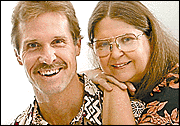


Health Options
Spring is rapidly turning to summer, and the number of weight-loss advertisements is increasing exponentially. But before you jump on the rapid-weight-loss bandwagon, learn a few scientific principles. Don’t fall for
diet gimmicksThe usual premise of these advertisements is that you can lose a tremendous amount of weight very quickly and look great in no time. And even though you know better, every time you read or hear the words "weight loss," you automatically think "fat loss."
Here are some weight-loss and fat-loss basics:
The main components of your body related to weight loss are water, protein and fat. Most protein is in muscles, and most fat is in fat cells. There is much more water in muscle tissue than in fat tissue.
You probably think that to lose weight, you need to burn up more calories than you eat. This is not exactly true. You can lose weight without burning any extra calories if your weight loss is all water.
Some weight-loss products bank on this and claim they reduce bloating or water retention. Many natural herbal products contain substances such as caffeine that stimulate your kidneys to eliminate water. The weight loss shows up quickly but is very temporary and represents no fat loss.
Average people store about a pound of carbohydrate in their bodies, in muscles and the liver in a form called glycogen. Glycogen is like a sponge, holding about three pounds of water. Glycogen and its associated water are the first to go on a low-calorie diet. With a low-carbohydrate diet, glycogen and its linked water can be lost in 24 hours. So, zap, there goes four pounds of weight off the scale with no fat loss.
Once the body's glycogen is gone, the continued rapid weight loss is primarily from the breakdown of protein in muscle tissue and the loss of the water associated with it. Thus, a quick 10-pound loss of weight is from glycogen, muscle and a minor amount of fat.
This weight loss is like exercise in reverse. Exercise preserves and builds muscle and burns fat. Quick weight loss without exercise results in lost muscle and preservation of fat.
When you lose muscle, you can gain weight back eating fewer calories than you did before you began dieting.
Typically, the weight regained is mostly fat, not muscle. Because of this, even before you return to your old weight, you may find your old wardrobe too tight.
Repeated 10-pound weight loss and gain could eventually leave one with more body fat.
Recent research presented by Dr. Paula Quatromoni at the Hawaii Dietetic Association spring conference last week indicates this is happening in the real world. Quatromoni reviewed data from the renowned Framingham study. Following the diets and weight changes of about 1,800 women, she found that those who tended to yo-yo in their weight (plus or minus 10 pounds) were more likely to be obese in 10 years. The types of foods the women ate appeared to have less effect on their risk of obesity than their weight fluctuation.
We've said it before but we'll say it again: To reach a healthy weight and maintain it requires regular physical activity and a reasonable, varied diet.
Health Events
Joannie Dobbs, Ph.D., C.N.S., is a food and nutrition consultant
and owner of Exploring New Concepts, a nutritional consulting firm.
She is also responsible for the nutritional analyses
indicated by an asterisk in this section.Alan Titchenal, Ph.D., C.N.S., is a sports nutritionist in the
Department of Human Nutrition, Food and Animal Science,
University of Hawaii-Manoa.